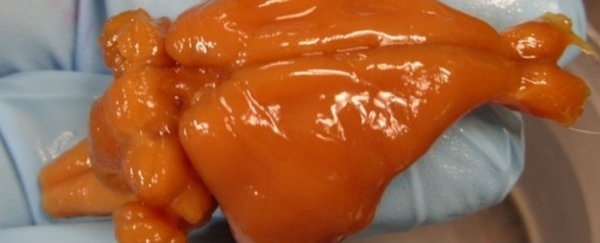For the first time, researchers have cryonically frozen a whole mammalian brain and recovered it in near-perfect condition, with the cell membranes, synapses, and intracellular structures all intact.
What this means is that all the components we think are required to form a personal identity - including memory and personality - could potentially be preserved for a long period of time, before either being uploaded to a computer for perpetuity, or reanimated some time in the future. Yep, it's what Walt Disney always dreamed of doing (but actually never attempted) and what Austin Powers mastered with spectacular awkwardness.
"This is a big deal," John Smart, co-founder of the non-profit Brain Preservation Foundation, told Motherboard. "It's the first time that we have a procedure that can protect everything neuroscientists think is involved with learning and memory. Given the results announced today, it seems to me that long-term memories are successfully preserved by this technique. This is not yet certain or universally agreed, but seems highly likely from my position."
The Brain Preservation Foundation awarded its five-year old "Small Mammal Brain Preservation Prize" to 21st Century Medicine - an independent research group lead by MIT graduate, Robert McIntyre - for coming up with the best technique to bring a frozen mammal's (a rabbit) brain back to life. The researchers have pocketed US$26,735 for their efforts.
Here's how they did it.
The team dispersed a chemical compound called glutaraldehyde into the internal structures of a rabbit's brain at the same time to stablise it and prevent decay. Then as it was undergoing cooling, they slowly added a cryoprotectant liquid to ensure that the connectome - the complex map of connections that keep the 86 billion neurons or so humming along - and synaptic structure weren't damaged in the process. This internal damage has been the number one reason why cryopreservation of the brain has failed so consistently in the past.
The whole thing was converted into a near glass-like structure by cooling it to -130 Celsius (-210 degrees Fahrenheit) over 4 hours, which prepared it for some serious long-term storage. When the team wanted to thaw it out, they just had to gently reheat the brain and flush out the cryoprotectant chemicals.
"[The] glutaraldehyde [bought] us weeks and the cryoprotectant [bought] us centuries," McIntyre told Gizmodo.
Judges assigned by the Brain Preservation Foundation were then tasked with figuring out exactly how intact the brain remained throughout the procedure, using electron microscopy imaging to make 'before and after' comparisons of the delicate structures.
"Every neuron and synapse looks beautifully preserved across the entire brain," Foundation president and judge, Kenneth Hayworth, told the press. "Simply amazing, given that I held in my hand this very same brain when it was frozen solid."
The new technique, called "Aldehyde-Stabilised Cryopreservation", has been published in the journal Cryobiology.
According to Claire Maldarelli at Popular Science, the technique was originally proposed in a 1986 book called Engines of Creation by engineer Eric Drexler, but wasn't tested until 2010, when Greg Fahy, the chief scientific officer of 21st Century Medicine, used it to preserve kidneys. Now that Fahy's team has managed to successfully apply it to a rabbit's brain, they're going to work on making it work for something bigger - a pig's brain.
So where does all of this leave us?
What the 21st Century Medicine team are trying to perfect is 'synthetic revival' - a modern form of cryopreservation that's focused on preserving the structure of the brain so it can be 'uploaded' to a computer or robot body in the future, rather than preserving the actual biological components to be transplanted into another body.
George Dvorsky explains at Gizmodo:
"The revived digital brain, also known as a whole brain emulation, could be uploaded into a computer simulation or robotic body. But because the system involves destructive scanning, the biological components of the original brain would be destroyed by the toxic chemical bath during the preservation process.
Following preservation and stabilisation, these brains would be cut into extremely fine slices, and then individually scanned. Together, the collection of digitised brain slices would represent an uninstantiated individual."
That's all well and good, but is there more to a person or animal's 'being' than an incredibly complex map of synapses and neurons firing electrical signals to each other? It's almost impossible to know without actually trying it - and I don't have to tell you how ethically ambigious that is. But figuring out exactly what goes into a brain - biologically speaking - to create the thoughts and feelings of a living thing is something scientists are determined to figure out.
"As to knowing that these techniques capture 'the rest of the person', including personality and consciousness: we will get there, but more slowly," Smart told Motherboard. "Consciousness is still not definitively understood in neuroscience, though neuroscientists are beginning to offer promising materialist models."
We're obviously a very long way away from applying any of this to humans, but excuse me while I daydream about waking up in a robot suit in 100 years time to find out that we still haven't figured out goddamn hoverboards.
